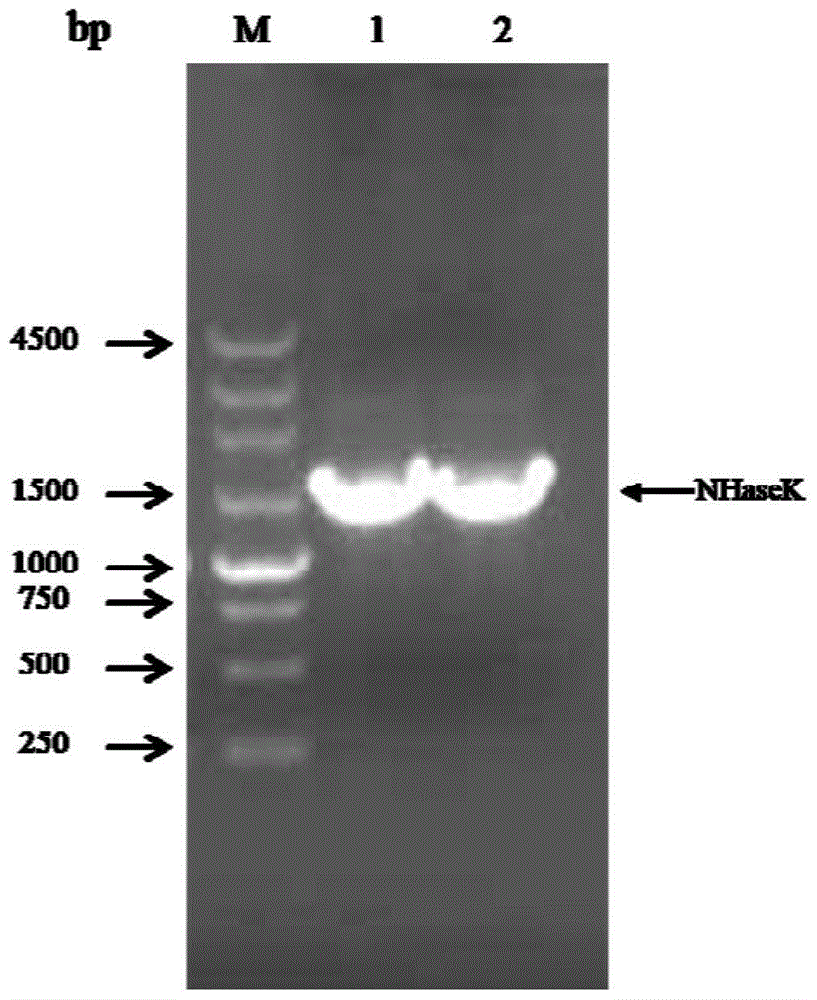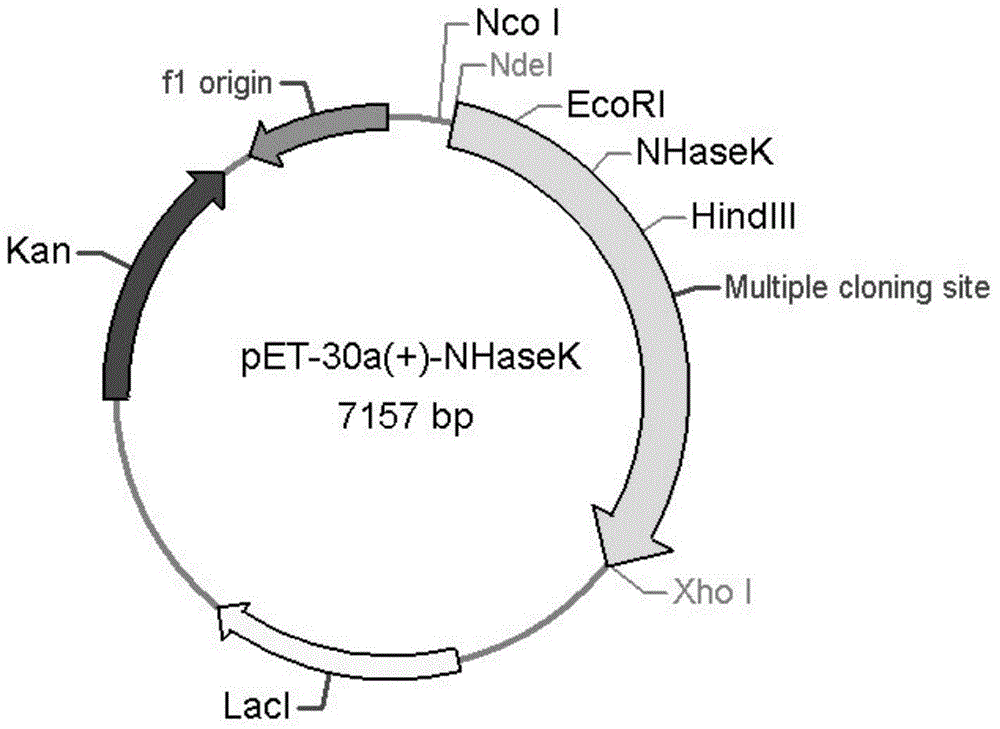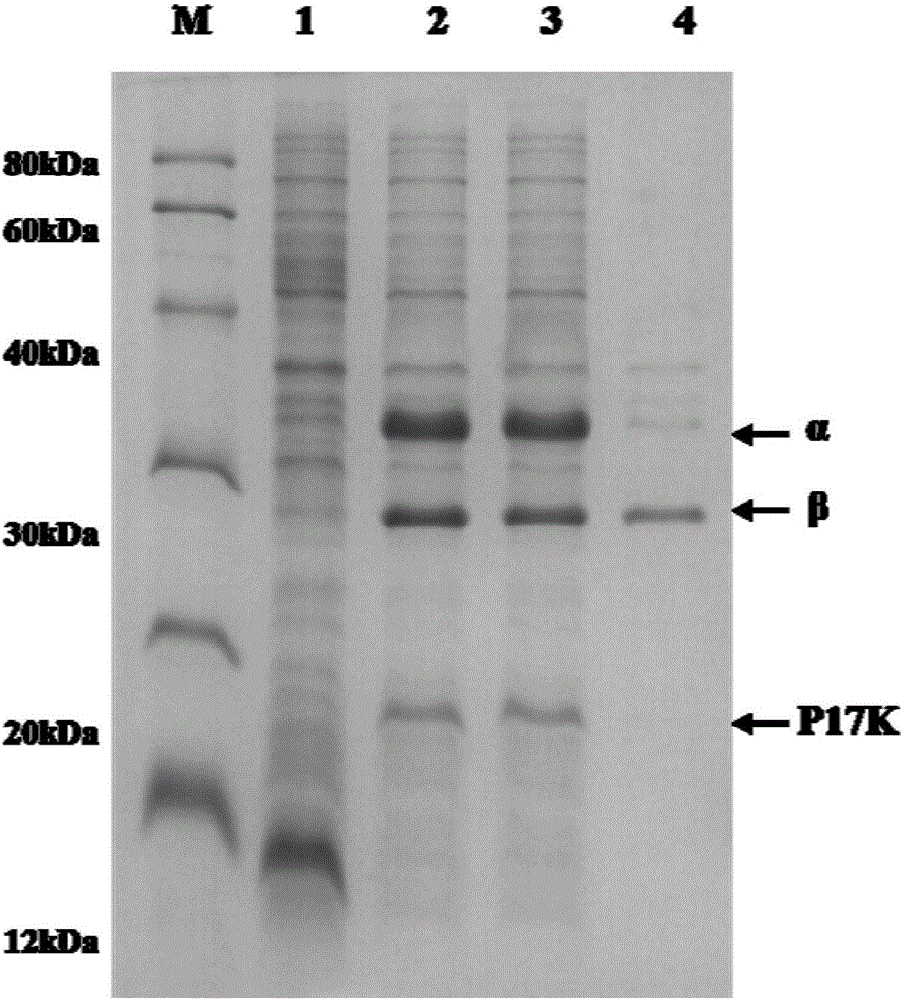Nitrile hydratase as well as encoding gene and application thereof
A nitrile hydratase and gene technology, applied in the field of nitrile hydratase and its coding gene and application, can solve the problems of poor substrate and product tolerance, low thermal stability, and restrictions on the industrial application of nitrile hydratase, and achieve high The effect of expression
- Summary
- Abstract
- Description
- Claims
- Application Information
AI Technical Summary
Problems solved by technology
Method used
Image
Examples
Embodiment 1
[0041] 1. Cloning of nitrile hydratase and its activator gene from the genome of Klebsiella oxytoca KCTC 1686 (Klebsiella oxytoca KCTC 1686)
[0042] Primers NH-F and NH-R were designed according to the genomic DNA sequence of Klebsiella oxytoca KCTC 1686 (GenBank accession number: CP003218.1).
[0043] NH-F sequence: 5'-CCG GAATTC ATGAGCCATAAACACGACCACG-3'
[0044]NH-R sequence: 5'-TTCCC AAGCTT GTTATGGTGTAACTCCATTATCG-3
[0045] Restriction sites EcoRI and HindIII (underlined) were added to the upstream and downstream primers, respectively. Klebsiella oxytoca KCTC 1686 genomic DNA was used as a template, and NH-F and NH-R were used as primers for PCR amplification. The PCR reaction system and reaction conditions were as follows:
[0046] PCR amplification system:
[0047]
[0048] PCR amplification conditions:
[0049] 1) Pre-denaturation: 95°C for 5 minutes;
[0050] 2) Denaturation: 98°C for 10s; Annealing: 57°C for 15s; Extension: 72°C for 60s; a total of 30 cy...
Embodiment 2
[0061] Example 2 Genetically engineered bacteria catalyze acrylonitrile to generate acrylamide
[0062] The enzyme activity unit is defined as: under the reaction conditions, the amount of enzyme that catalyzes the substrate reaction to produce 1 μmol of product per minute.
[0063] Take 25ml of the fermentation broth of the engineering bacteria E.coli BL21(DE3) / pET-30a(+)-NHaseK in Example 1, centrifuge at 10000rpm for 10min to collect the bacterial cells, and then resuspend with 250ml of 50mM Tris-HCl (pH 7.5) buffer Bacteria cells, that is, the resting cell suspension of engineering bacteria E.coli BL21(DE3) / pET-30a(+)-NHaseK. 1.5 ml of acrylonitrile was added to the resuspension, and the hydration reaction was carried out at 35°C for 2 hours. Then the contents of acrylonitrile and acrylamide in the reaction system were detected by gas chromatography. As a result, it was found that no acrylonitrile remained in the reaction system, and all of them were converted into acryl...
Embodiment 3
[0064] Example 3 Genetically engineered bacteria catalyze butyronitrile to generate butanamide
[0065] Take 25ml of the fermentation broth of the engineering bacteria E.coli BL21(DE3) / pET-30a(+)-NHaseK in Example 1, centrifuge at 10000rpm for 10min to collect the bacteria, and then resuspend with 250ml of 50mM Tris-HCl (pH 7.0) buffer Bacteria cells, that is, the resting cell suspension of engineering bacteria E.coli BL21(DE3) / pET-30a(+)-NHaseK. Add 7.0 g of butyronitrile to the resuspension liquid, carry out hydration reaction at 35° C., and react for 2 hours. Then detect the content of butyronitrile and butyramide in the reaction system with gas chromatography. As a result, it was found that there was no residue of butyronitrile in the reaction system, and all of them were converted into butanamide.
PUM
| Property | Measurement | Unit |
|---|---|---|
| Pre-denatured | aaaaa | aaaaa |
| Extend | aaaaa | aaaaa |
Abstract
Description
Claims
Application Information
 Login to View More
Login to View More - R&D
- Intellectual Property
- Life Sciences
- Materials
- Tech Scout
- Unparalleled Data Quality
- Higher Quality Content
- 60% Fewer Hallucinations
Browse by: Latest US Patents, China's latest patents, Technical Efficacy Thesaurus, Application Domain, Technology Topic, Popular Technical Reports.
© 2025 PatSnap. All rights reserved.Legal|Privacy policy|Modern Slavery Act Transparency Statement|Sitemap|About US| Contact US: help@patsnap.com



